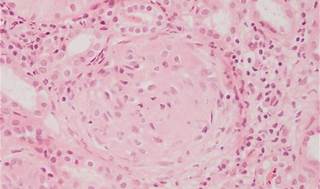The nurse is evaluating a child with acute glomerulonephritis who presents at the clinic with increased fatigue, facial swelling, and decreased appetite. The child’s urine sample is dark yellow. What additional finding should the nurse report to the healthcare provider?
Blood pressure 88/50 mmHg
Weight loss
Maculopapular rash over the trunk of the body
Positive rapid strep test of the oropharynx
The Correct Answer is D

The correct answer is choice d. Positive rapid strep test of the oropharynx.
Choice A rationale:
Blood pressure of 88/50 mmHg is lower than normal but not typically associated with acute glomerulonephritis. High blood pressure is more common in this condition.
Choice B rationale:
Weight loss is not a typical symptom of acute glomerulonephritis. Instead, fluid retention and weight gain are more common due to edema.
Choice C rationale:
A maculopapular rash over the trunk is not commonly associated with acute glomerulonephritis. This condition usually presents with symptoms like hematuria, proteinuria, and edema.
Choice D rationale:
A positive rapid strep test of the oropharynx indicates a recent streptococcal infection, which is a common cause of acute glomerulonephritis. Reporting this finding is crucial for appropriate management.
Nursing Test Bank
Naxlex Comprehensive Predictor Exams
Related Questions
Correct Answer is B
Explanation
Choice A rationale
A fecal-fat test is used to measure the body’s ability to break down and absorb fat. It is not a standard diagnostic test for cystic fibrosis (CF)6.
Choice B rationale
A sweat-chloride test is the standard diagnostic test for CF. People with CF have higher than normal levels of sodium and chloride in their sweat, which can make their skin taste salty.
Choice C rationale
A pulmonary-function test measures how well the lungs work and can be used to monitor lung disease in people with CF. However, it is not a standard diagnostic test for CF, especially in a 2- month-old infant.
Choice D rationale
A potassium chloride test is not a standard diagnostic test for CF6.
Correct Answer is D
Explanation
The correct answer is choice d. Measure the blood pressure twice more during the visit and calculate the average of the three readings.
Choice A rationale:
Referring the child to the healthcare provider and scheduling a blood pressure evaluation in two weeks is not the immediate next step. It is important to confirm the elevated blood pressure reading during the same visit before making any referrals.
Choice B rationale:
Performing a comprehensive assessment and avoiding repeated blood pressure measurements is not appropriate. Repeated measurements are necessary to confirm the initial finding of elevated blood pressure.
Choice C rationale:
Taking the child’s blood pressure three times and recording the highest reading is not the best practice. The highest reading might not be representative of the child’s true blood pressure.
Choice D rationale:
Measuring the blood pressure twice more during the visit and calculating the average of the three readings is the correct approach. This method helps to ensure that the blood pressure reading is accurate and not influenced by temporary factors such as anxiety or movement.
Whether you are a student looking to ace your exams or a practicing nurse seeking to enhance your expertise , our nursing education contents will empower you with the confidence and competence to make a difference in the lives of patients and become a respected leader in the healthcare field.
Visit Naxlex, invest in your future and unlock endless possibilities with our unparalleled nursing education contents today
Report Wrong Answer on the Current Question
Do you disagree with the answer? If yes, what is your expected answer? Explain.
Kindly be descriptive with the issue you are facing.
